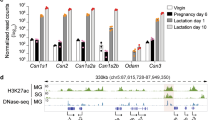Abstract
The murine PSP gene is expressed at a high-level in the parotid glands. To extend the knowledge of parotid gland expression and develop tools for expression of heterologous proteins in this tissue, the regulation of the PSP gene was studied using transgenic mice. High-level parotid gland expression of the PSP gene was indicated to depend on a novel regulatory region situated between −8.0 and −6.5 kb. Together with previous results this indicates that the main regulatory elements in the PSP gene are situated between −8.0 to −3.1 kb. This region was shown to activate a heterologous SV40 early promoter in the parotid glands of transgenic mice, suggesting that the PSP gene is controlled by enhancer sequences. A novel Psp derived 9.7 kb parotid gland expression cassette, Lama IV, carrying all known regulatory regions in the PSP gene was expressed at high-levels in the parotid glands and should prove highly useful for expression of heterologous proteins in the saliva of transgenic mice.
Similar content being viewed by others
References
Bobek, L.A., Li, H., Rojstaczer, C., Jones, C., Gross, K.W. and Levine, M.J. (1998) Tissue-specific expression of human salivary mucin, MUC7, in transgenic mice. Transgenic Res. 7, 195-204.
Bonifer, C., Vidal., M., Grosveld, F. and Sippel, A.E. (1990) Tissue specific and position independent expression of the complete gene domain for chicken lysozyme in transgenic mice. EMBO J. 9, 2843-8.
Chomczynski, P. and Sacchi, N. (1987) Single step RNA isolation by acid guanidium thiocyanate phenol chloroform extraction. Analytical Biochemistry 162, 156-9.
Church, G.M. and Gilbert, W. (1984) Genomic Sequencing. Proc. Natl. Acad. Sci. USA 81, 1991-5.
Dandoy-Dron, F., Itier, J.M., Monthioux, E., Bucchini, D. and Jami, J. (1995) Tissue-specific expression of the rat insulin 1 gene in vivo requires both the enhancer and promoter regions. Differentiation 58, 291-5.
Goldberg, H., Helaakoski, T., Garrett, L.A., Karsenty, G., Pellegrino, A., Lozano, G., Maity, S. and de Crombrugghe, B. (1992) Tissue-specific expression of the mouse alpha 2(I) collagen promoter. Studies in transgenic mice and in tissue culture cells. J. Biol. Chem. 267, 19622-30.
Hall, J., Ali, S., Surani, A., Hazlewood, G.P., Clark, A.J, Simons, J.P., Hirst, B.H. and Gilbert, H.J. (1993) Manipulation of the repertoire of digestive enzymes secreted into the gastrointestinal tract of transgenic mice. bio/technology 11, 376-9.
Hogan, B., Costantini, F. & Lacy, E. (1986) Manipulating the mouse embryo: a laboratory manual. Cold Spring Harbor Laboratory Press. New York.
Kroon, E., MacDonald, R.J. and Hammer, R.E. (1997) The transcriptional regulatory strategy of the rat tissue kallikrein gene family. Genes and function 1, 309-19.
Larsen, H.J., Brodersen, C.H. & Hjorth, J.P. (1994) High-level salivary gland expression in transgenic mice, Transgenic Res. 3, 311-6.
Laursen, J. and Hjorth, J.P. (1997) A casette for high-level expression in the mouse salivary glands. Gene 198, 367-72.
Lin, H.H. and Ann, D.K. (1992) Identification of cis-and transacting factors regulating the expression of rat salivary-specific RP4 gene. Gen. Expr. 2, 365-377.
Lin, H.H., Li, W.-Y. and Ann, D.K. (1993) The Helix-Loop-Helix Proteins (Salivary-specific cAMP Response Element-binding Proteins) can Modullate cAMP-inducible RP4 Gene Expression in Salivary Cells. J. Biol. Chem. 268, 10214-20.
Liu, Z.Y., Chin, K. and Noguchi, C.T. (1994) Tissue specific expression of human erythropoietin receptor in transgenic mice. Dev. Biol. 166, 159-69.
Maden, B.E.H., Dent, C.L., Farrell, T.E., Garde, J., McCallum, F.S. and Wakeman, J.A. (1987) Clones of human ribosomal DNA containing the complete 18 S-rRNA and 28 S-rRNA genes. Biochem. J. 246, 519-27.
Madsen, H.O. and Hjorth, J.P. (1985) Molecular cloning of mouse PSP cDNA. Nucleic Acids Res. 13, 1-13.
Mastrangeli, A., O'Connell, B., Aladib, W., Fox, P.C., Baum, B.J. and Crystal, R.G. (1994) Direct in vivo adenovirus-mediated gene transfer to salivary glands. Am. J. Physiol. 266, G1146-55.
Mikkelsen, T.R., Brandt, J., Larsen, H.J., Larsen, B.B., Poulsen, K., Ingerslev, Din, N. and Hjorth, J.P. (1992) Tissue-specific expression in the salivary glands of transgenic mice. Nucleic Acids Res. 20, 2249-55.
Miquerol, L., Cluzeaud, F., Porteu, A., Alexandre, Y., Vandewalle, A. and Kahn, A. (1996) Tissue specificity of L-pyruvate kinase transgenes results from the combinatorial effect of proximal promoter and distal activator regions. Gene Expr. 5, 315-30.
Nielsen, J.T. (1982) Variation in amylase haplotypes among congenic lines of the house mouse. Genetics 102, 571-82.
Sambrook, J., Fritch, E.F. and Maninatis, T. (1989) Molecular cloning: a laboratory manual. Cold Spring Harbor Laboratory Press. New York.
Samuelson, L.C. (1996) Transgenic approaches to salivary gland research. Annu. Rev. Physiol. 58, 209-29.
Shaw, P. and Schibler, U. (1986) Structure and expression of the parotid secretory protein of mouse. J. Mol. Biol. 192, 567-76.
Svendsen, P., Laursen, J., Krogh-Pedersen, H. and Hjorth, J.P. (1998) Novel salivary gland specific binding elements located in the PSP proximal enhancer. Nucleic Acids Res. 26, 2761-70.
Ting, C-N., Rosenberg, M.P., Snow, C.M., Samuelson, L.C. and Meisler, M.H. (1992) Endogenous retroviral sequences are required for tissue-specific expression of a human salivary amylase gene. Genes & Dev. 6, 1457-65.
Tu, Z.-J., Lazowski, K.W., Ehlenfeldt, R.G., Wu, G., Lin, H.H., Kousvelari, E. and Ann, D.K. (1993) Isoproterenol/tannin-dependent R15 expression in transgenic mice is mediated by an upstream parotid control region. Gene Expr. 3, 289-305.
Widlak, W., Markkula, M., Krawczyk, Z., Kananen, K. and Huhtaniemi, I. (1995) A 252 bp upstream region of the rat spermatocyte-specific hst70 gene is sufficient to promote expression of the hst70-CAT hybrid gene in testis and brain of transgenic mice. Biochim. Biophys. Acta 1264, 191-200.
Zhou, L., Messing, A. and Azen, E.A. (1997) Proline-rich-protein promoters direct LacZ expression to the granular convoluted tubular cells of the submandibular gland in adult transgenic mice. Transgenic Res. 6, 19-25.
Author information
Authors and Affiliations
Rights and permissions
About this article
Cite this article
Laursen, J., Krogh-pedersen, H., Dagnaes-hansen, F. et al. The Main Regulatory Region in the Murine PSP Gene is a Parotid Gland Enhancer. Transgenic Res 7, 413–420 (1998). https://doi.org/10.1023/A:1008806325102
Issue Date:
DOI: https://doi.org/10.1023/A:1008806325102




